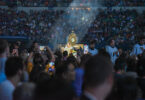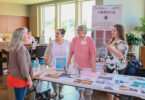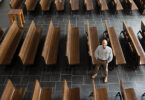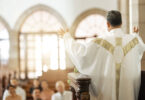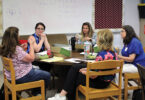150th anniversary celebration gives parishioners a chance to renew old acquaintances
by Joe Bollig
joe.bollig@theleaven.org
EUDORA — Back in the day — just a couple of years before the Civil War — getting to Mass was a difficult, if not dangerous, endeavor for Catholics here.
The nearest Catholic church was in Lawrence. And whereas today, a driver can zip down K-10 and be in Lawrence in five or 10 minutes (longer on a game day, of course), in 1859 the 10-mile trip took an entire day.
Mass-goers had navigate a dirt trail, ford the Wakarusa River at Blue Jacket Crossing, and cut through the Franklin Bottoms. They had to be on the lookout for ruffians and renegades, and contend with the vagaries of Kansas weather.
Mission priests traveling to Eudora from Shawnee Mission had to endure the same.
No wonder Eudora Catholics, mostly Germans, wanted their own parish — and the pioneer Bishop John B. Miege was disposed to grant them one.
The hardscrabble origins of Holy Family Parish in Eudora were recalled Oct. 10-11 at events celebrating the 150th anniversary of the parish’s founding.
On Oct. 10, pastor Father Pat Riley celebrated a Mass at 9 a.m. in the original 1864 church. An all-day open house followed, with a display of parish artifacts in the old church, spanning 150 years. Father Riley then celebrated another Mass at 5 p.m., and a dance was held in the parish hall that evening.
On Sunday, Archbishop Joseph F. Naumann was the main celebrant and homilist at a 10 a.m. Mass, with Father Riley as concelebrant. Father John Riley was master of ceremonies. Following Mass, a dinner was served in Eudora Middle School, and the parish held another open house from 2 to 8 p.m.
A memorial card, a CD with hundreds of historic photos, and a commemorative parish history book were on sale or given out to parishioners.
The artifacts on display tell a lot about the history of the parish. They included the original front door key, prayer books in German that were carried by the original settlers, tools used to built the altar in the old church, a portable wooden confessional, a handmade rosary, wedding dresses and baptismal gowns, and faux stained-glass windows.
The windows, which were painted to give the appearance of stained glass, are a recent find, said Janet Campbell, who grew up in Eudora and wrote the commemorative 150th anniversary history.
“[The windows] were found in the crawl space of the church,” said Campbell. “The ladies who put up the displays found them and brought them up for display.”
The sesquicentennial was also a time to share great memories.
“I drove a horse and buggy to school for two or three years,” said Jay Grosdidier, 92, the oldest active parishioner. “That was in the 1920s, and everyone in town had a barn behind their house. The Sisters had a horse barn where they lived. My granddad lived about a half block away, and he’d stable the horse.”
“The horse knew where he was going, so you didn’t have to do much driving,” Grosdidier continued. “It wasn’t hard to drive a horse. It got pretty cold, and I would take [my younger sister and brother] to school with me. Mother would heat bricks up for the floor of the buggy and we used a big robe. We never got real cold.”
Most parish history concerned the usual elements of sacramental life — weddings, funerals, baptisms, first Communions, and so on, said Campbell. Occasionally there was excitement, like during Prohibition days when the police halted Mass so they could arrest a bootlegger.
And the 150th anniversary was a time for renewing personal ties and connections.
A couple from Lenexa, who married in the old church 52 years ago, posed for photos again in front of the old altar during the open house.
Lots of former parishioners came home to meet and reminisce, said Campbell. She got e-mail enquiries from as far away as California. Her husband brought an 85-year-old former parishioner, who had had a stroke, to the celebration.
“He said now he was ready to ‘go east,’” said Campbell. “He was ready to die a happy man.”
The celebration wasn’t just a Catholic affair; Eudora citizens of other faiths participated as well. The women of St. Paul’s United Church of Christ and the Eudora United Methodist Church served the catered dinner so their Catholic neighbors could enjoy the meal.
This kind of ecumenism has a long history in Eudora. Before the church was built, Mass was celebrated in a storefront owned by two Jewish brothers. Lutheran families sent their children to the Catholic school during the early years.
In the 1860s, Eudorans of all faiths helped buy and install the first church’s bell which kept everybody on time. This cooperation was repeated in 1967 when townspeople helped build a new bell tower for the new school and church.
Eudorans didn’t have much use for those who would disturb this unity.
“One woman remembered the Ku Klux Klan tried to establish a lodge in Eudora,” said Campbell. “[A Klan representative] came to her family’s front door. Her father told him [the Klan] was a bunch of cowards. He happened to be editor of the paper and he wrote a story about them.”
The lesson of the sesquicentennial, said Campbell, is that Holy Family Catholics are determined and persistent. They are survivors, having outlasted drought, wars, depressions and personal struggles.
“This 150th celebration has brought people together to reminisce as we’ve cleaned out our attics,” she said. “It has strengthened our parish, and hopefully someone will write about our 300th anniversary someday.”
Holy Family Timeline
• 1859 — Catholic settlers in the Eudora area appeal to Bishop John B. Miege to send a missionary priest, as the 10-mile journey to Lawrence was difficult. He agrees, and a priest arrives once a month to celebrate Mass in borrowed space in a storefront.
• 1861 — The Catholic population of Eudora and environs grows to 20 families with the influx of German and Irish settlers. Parishioners decide to begin construction of a sandstone church.
• 1864 — The church is completed and dedicated. Soon after, a rectory is built. A few years later, it was converted into a school, and a house for teaching Sisters was built. The whole town pitched in to buy a bell, by which the city kept time for many years.
• 1886-1891 — The church is expanded with the construction of a sacristy on the southeast corner.
• 1892 — The old school is sold.
• 1893 — A new school is built and dedicated, and the Ursuline Sisters of Paola arrive to teach. The school closes due to lack of students and funds, and the building is turned into a parish hall.
• 1896 — Two silver chalices are stolen, but recovered two weeks later.
• 1897 — A vestibule and steeple are added.
• 1899 — The parish gets an organ.
• 1921 — A new altar is built for the church by parishioner Frank Sommer.
• 1924 — A new school is built using material from the old parish hall. The Benedictine Sisters of Mount St. Scholastica in Atchison arrive to teach. The old Sisters’ house was sold, and the pastor gave the rectory to the Benedictine Sisters.
• 1935 — The parish grows to 35 families.
• 1950s (late) — The steeple is blown down during a thunderstorm.
• 1963 — Regular celebration of Mass ends in the old church when the new church and school are completed. Just as in the 1860s, the whole town helps install the new bells in the new bell tower.
• 1964 — The parish celebrates its centennial.
• 1970 — The parish school is closed, but the classrooms continue to be used for the parish religious education program. • 1981 — Restoration of the old church is completed.

